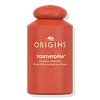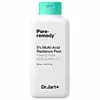What's inside
What's inside
 Key Ingredients
Key Ingredients

 Benefits
Benefits

 Concerns
Concerns

 Ingredients Side-by-side
Ingredients Side-by-side

Water
Skin ConditioningDicaprylyl Carbonate
EmollientHamamelis Virginiana Water
AstringentOctyldodecanol
EmollientPropanediol
SolventButylene Glycol
HumectantLactic Acid
BufferingPolysorbate 20
EmulsifyingSodium Hydroxide
BufferingGlycolic Acid
BufferingVinegar
Tartaric Acid
BufferingTrehalose
HumectantHydrogenated Lecithin
EmulsifyingPyrus Malus Fiber
AbrasiveMalus Domestica Fruit Cell Culture Extract
Skin ConditioningLactobacillus Ferment
Skin ConditioningZingiber Officinale Root Extract
MaskingOlea Europaea Fruit Extract
BleachingSalicylic Acid
MaskingGlucosamine Hcl
Betaine
HumectantFerula Galbaniflua Resin Oil
AntimicrobialLitsea Cubeba Fruit Oil
MaskingGlycine Soja Oil
EmollientGlycerin
HumectantPullulan
Sclerotium Gum
Emulsion StabilisingTocopherol
AntioxidantMaltodextrin
AbsorbentLecithin
EmollientCarbomer
Emulsion StabilisingXanthan Gum
EmulsifyingLinalool
PerfumingCitral
PerfumingFarnesol
PerfumingSodium Citrate
BufferingSilica
AbrasivePhenoxyethanol
PreservativeBenzoic Acid
MaskingWater, Dicaprylyl Carbonate, Hamamelis Virginiana Water, Octyldodecanol, Propanediol, Butylene Glycol, Lactic Acid, Polysorbate 20, Sodium Hydroxide, Glycolic Acid, Vinegar, Tartaric Acid, Trehalose, Hydrogenated Lecithin, Pyrus Malus Fiber, Malus Domestica Fruit Cell Culture Extract, Lactobacillus Ferment, Zingiber Officinale Root Extract, Olea Europaea Fruit Extract, Salicylic Acid, Glucosamine Hcl, Betaine, Ferula Galbaniflua Resin Oil, Litsea Cubeba Fruit Oil, Glycine Soja Oil, Glycerin, Pullulan, Sclerotium Gum, Tocopherol, Maltodextrin, Lecithin, Carbomer, Xanthan Gum, Linalool, Citral, Farnesol, Sodium Citrate, Silica, Phenoxyethanol, Benzoic Acid
Water
Skin ConditioningC9-12 Alkane
SolventButylene Glycol
HumectantGlycerin
HumectantCitric Acid
BufferingSodium Hydroxide
BufferingLactic Acid
BufferingHelianthus Annuus Seed Oil
EmollientTartaric Acid
BufferingIsononyl Isononanoate
EmollientLactobacillus Ferment
Skin ConditioningAlgae Extract
EmollientHoney
HumectantCaffeine
Skin ConditioningCamellia Sinensis Leaf Extract
AntimicrobialCurcuma Longa Root Extract
MaskingChamomilla Recutita Extract
Skin ConditioningLaminaria Saccharina Extract
Skin ProtectingPanthenol
Skin ConditioningSodium Hyaluronate
HumectantXanthan Gum
EmulsifyingCarbomer
Emulsion StabilisingSalicylic Acid
MaskingDi-C12-18 Alkyl Dimonium Chloride
Skin ConditioningHydrogenated Lecithin
EmulsifyingLaureth-4
EmulsifyingGlycine
BufferingSerine
MaskingGlutamic Acid
HumectantAspartic Acid
MaskingLeucine
Skin ConditioningAlanine
MaskingTyrosine
MaskingArginine
MaskingLysine
Skin ConditioningProline
Skin ConditioningPhenylalanine
MaskingThreonine
Isoleucine
Skin ConditioningValine
MaskingHistidine
HumectantParfum
MaskingLimonene
PerfumingCitronellol
PerfumingGeraniol
PerfumingLinalool
PerfumingCitral
PerfumingDisodium EDTA
Sodium Citrate
BufferingTocopheryl Acetate
AntioxidantBHT
AntioxidantPhenoxyethanol
PreservativePotassium Sorbate
PreservativeWater, C9-12 Alkane, Butylene Glycol, Glycerin, Citric Acid, Sodium Hydroxide, Lactic Acid, Helianthus Annuus Seed Oil, Tartaric Acid, Isononyl Isononanoate, Lactobacillus Ferment, Algae Extract, Honey, Caffeine, Camellia Sinensis Leaf Extract, Curcuma Longa Root Extract, Chamomilla Recutita Extract, Laminaria Saccharina Extract, Panthenol, Sodium Hyaluronate, Xanthan Gum, Carbomer, Salicylic Acid, Di-C12-18 Alkyl Dimonium Chloride, Hydrogenated Lecithin, Laureth-4, Glycine, Serine, Glutamic Acid, Aspartic Acid, Leucine, Alanine, Tyrosine, Arginine, Lysine, Proline, Phenylalanine, Threonine, Isoleucine, Valine, Histidine, Parfum, Limonene, Citronellol, Geraniol, Linalool, Citral, Disodium EDTA, Sodium Citrate, Tocopheryl Acetate, BHT, Phenoxyethanol, Potassium Sorbate
Ingredients Explained
These ingredients are found in both products.
Ingredients higher up in an ingredient list are typically present in a larger amount.
Butylene Glycol (or BG) is used within cosmetic products for a few different reasons:
Overall, Butylene Glycol is a safe and well-rounded ingredient that works well with other ingredients.
Though this ingredient works well with most skin types, some people with sensitive skin may experience a reaction such as allergic rashes, closed comedones, or itchiness.
Learn more about Butylene GlycolCarbomer is a polymer of acrylic acid. Its main role is to create a gel consistency.
A high amount of carbomer can cause pilling or balling up of products. Don't worry, most products contain 1% or less of carbomer.
Citral is a fragrance and used to add a lemon-like scent to products. It is both naturally found in plants and created synthetically. In plants, it is commonly occurring in lemon myrtle, lemongrass, lemon tea-tree, lemon verbena, and other citruses.
The EU mandates Citral be listed separately as a fragrance. It is a known allergen and may cause contact dermatitis. Citral can also used as a masking ingredient.
The term 'fragrance' is not regulated in many countries. In many cases, it is up to the brand to define this term. For instance, many brands choose to label themselves as "fragrance-free" because they are not using synthetic fragrances. However, their products may still contain ingredients such as essential oils that are considered a fragrance.
The term 'citral' is a collective term for two geometric isomers: geranial/Citral A and neral/Citral B.
Learn more about CitralGlycerin is already naturally found in your skin. It helps moisturize and protect your skin.
A study from 2016 found glycerin to be more effective as a humectant than AHAs and hyaluronic acid.
As a humectant, it helps the skin stay hydrated by pulling moisture to your skin. The low molecular weight of glycerin allows it to pull moisture into the deeper layers of your skin.
Hydrated skin improves your skin barrier; Your skin barrier helps protect against irritants and bacteria.
Glycerin has also been found to have antimicrobial and antiviral properties. Due to these properties, glycerin is often used in wound and burn treatments.
In cosmetics, glycerin is usually derived from plants such as soybean or palm. However, it can also be sourced from animals, such as tallow or animal fat.
This ingredient is organic, colorless, odorless, and non-toxic.
Glycerin is the name for this ingredient in American English. British English uses Glycerol/Glycerine.
Learn more about GlycerinHydrogenated Lecithin is created from the hydrogenation of lecithin (a group of phospholipids). Hydrogenation is a chemical reaction between hydrogen and another element.
This ingredient is an emollient and emulsifier. As an emollient, it helps soften skin by trapping moisture within. As an emulsifier, it prevents oil and water ingredients from separating.
Lactic Acid is another well-loved alpha hydroxy acid (AHA). It is gentler than glycolic acid but still highly effective.
Its main role is to exfoliate the surface of the skin by loosening the “glue” that holds dead skin cells together. Shedding those old cells leads to smoother, softer, and more even-toned skin.
Because lactic acid molecules are larger than glycolic acid, they don’t penetrate as deeply. This means they’re less likely to sting or irritate, making it a great choice for beginners or those with sensitive skin.
Like glycolic acid, it can:
Lactic acid also acts as a humectant (like hyaluronic acid). It can draw water into the skin to improve hydration and also plays a role in the skin's natural moisturizing factor (NMF) in the form of sodium lactate.
Studies show it can boost ceramide production to strengthen the skin barrier and even help balance the skin’s microbiome.
To get results, choose products with a pH between 3-4.
Lower strengths (5-12%) focus on surface exfoliation; higher strengths (12% and up) can reach deeper in the dermis (deeper, supportive layer) to improve skin texture and firmness over time.
Though it was originally derived from milk, most modern lactic acid used in skincare is vegan. It is made through non-dairy fermentation to create a bio-identical and stable form suitable for all formulations.
When lactic acid shows up near the end of an ingredient list, it usually means the brand added just a tiny amount to adjust the product’s pH.
Legend has it that Cleopatra used to bathe in sour milk to help reduce wrinkles.
Lactic acid is truly a gentle multitasker: it exfoliates, hydrates, strengthens, and brightens. It's a great ingredient for giving your skin a smooth, glowing, and healthy look without the harshness of stronger acids.
Read more about some other popular AHA's here:
Learn more about Lactic AcidLactobacillus Ferment is created by fermenting the Lactobacillus bacteria. It helps keep our skin's natural barrier and microbiome healthy.
Studies show lactobacillus ferment to be effective at repairing the skin barrier. Having a healthy skin barrier helps keep your skin healthy and hydrated. It also protects against bad bacteria.
As a probiotic/prebiotic/postbiotic, Lactobacillus ferment can help regular our natural biome. In fact, one study found a lack of diversity in our natural skin biome can trigger acne.
Learn more about Lactobacillus FermentLinalool is a fragrance and helps add scent to products. It's derived from common plants such as cinnamon, mint, citrus, and lavender.
Like Limonene, this ingredient oxidizes when exposed to air. Oxidized linalool can cause allergies and skin sensitivity.
This ingredient has a scent that is floral, spicy tropical, and citrus-like.
Learn more about LinaloolPhenoxyethanol is a preservative that has germicide, antimicrobial, and aromatic properties. Studies show that phenoxyethanol can prevent microbial growth. By itself, it has a scent that is similar to that of a rose.
It's often used in formulations along with Caprylyl Glycol to preserve the shelf life of products.
Salicylic Acid (also known as beta hydroxy acid or BHA) is a well-known ingredient for treating skin that struggles with acne and clogged pores. It exfoliates both the skin's surface and deep within the pores to help clear out buildup, control oil, and reduce inflammation.
Unlike AHAs (alpha hydroxy acids), salicylic acid is oil-soluble. This allows it to penetrate into pores which makes it especially effective for treating blackheads and preventing future breakouts.
Salicylic acid is also known for its soothing properties. It has a similar structure to aspirin and can calm inflamed or irritated skin, making it a good option for acne-prone skin that is also sensitive.
Concentrations of 0.5-2% are recognized by the U.S. FDA as an over-the-counter topical acne product.
It can cause irritation and/or dryness if one's skin already has a compromised moisture barrier, so it's best to focus on repairing that before introducing this ingredient into your routine.
While salicylic acid does not increase sun sensitivity, it’s still important to wear sunscreen daily to protect your skin.
If you are looking for the ingredient called BHA or Butylated Hydroxyanisole, click here.
Learn more about Salicylic AcidSodium Citrate is the sodium salts of citric acid. In skincare, it is used to alter pH levels and acts as a preservative.
Its main functions are to maintain the pH of a product and neutralize metal ions.
The acidity of our skin is maintained by our glands and skin biome; normal pH level of skin is slightly acidic (~4.75-5.5).
Being slightly acidic allows our skin to create an "acid mantle". This acid mantle is a thin barrier that protects our skin from bacteria and contaminants.
Learn more about Sodium CitrateSodium Hydroxide is also known as lye or caustic soda. It is used to adjust the pH of products; many ingredients require a specific pH to be effective.
In small amounts, sodium hydroxide is considered safe to use. However, large amounts may cause chemical burns due to its high alkaline.
Your skin has a natural pH and acid mantle. This acid mantle helps prevent harmful bacteria from breaking through. The acid mantle also helps keep your skin hydrated.
"Alkaline" refers to a high pH level. A low pH level would be considered acidic.
Learn more about Sodium HydroxideTartaric acid is an AHA with exfoliating and antioxidant properties. It is found in many fruits, such as tamarind, grapes, bananas, and avocados.
AHAs provide chemical exfoliation, helping to improve skin tone and texture.
Tartaric acid is not as well studied as other AHAs, such as glycolic acid.
Learn more about Tartaric AcidWater. It's the most common cosmetic ingredient of all. You'll usually see it at the top of ingredient lists, meaning that it makes up the largest part of the product.
So why is it so popular? Water most often acts as a solvent - this means that it helps dissolve other ingredients into the formulation.
You'll also recognize water as that liquid we all need to stay alive. If you see this, drink a glass of water. Stay hydrated!
Learn more about WaterXanthan gum is used as a stabilizer and thickener within cosmetic products. It helps give products a sticky, thick feeling - preventing them from being too runny.
On the technical side of things, xanthan gum is a polysaccharide - a combination consisting of multiple sugar molecules bonded together.
Xanthan gum is a pretty common and great ingredient. It is a natural, non-toxic, non-irritating ingredient that is also commonly used in food products.
Learn more about Xanthan Gum